News
Research conference on quantum materials (November 8-18, 2021)
Michigan State University, in partnership with CINT at Los Alamos National Lab, is hosting a major research conference—the 7th Conference on Photoinduced Phase Transitions and Cooperative Phenomena (PIPT7) this month. The conference is an international meeting bringing together leading experimentalists and theorists in the field of photoinduced phase transitions in cooperative systems. This year’s conference will focus on the control science of quantum materials. These quantum materials, often also referred to as strongly correlated electron materials are featured by their complex phase diagrams where multiple electronic phases often occur adjacently. The rich variety of ordered states—including superconductivity, electronic crystals, magnetic orders, and collective topological states—emerge as a consequence of the astounding properties of quantum mechanics. The research on quantum materials has gained momentum recently driven by the desire to harness the functionalities beyond the conventional semiconductors.
In the past several decades, the intriguing discoveries of the quantum phases strongly interacting with light fields on the ultrafast timescales defy the intuitive understanding of how electronic materials shall behave and thus gave rise to a new field of ultrafast material research, now dubbed photoinduced phase transition (PIPT). Whereas ultrafast nonthermal control of quantum materials is poised to new ways of engineering quantum phases, the mechanism to exert control is rooted in nonequilibrium quantum many-body physics.
Probing nonequilibrium physics behind spontaneous symmetry breaking in quantum materials
.png)
Quantum material systems upon applying ultrashort laser pulses provide a rich platform to access excited material phases and their transformations that are not entirely like their equilibrium counterparts. The addressability and potential controls of metastable or long-trapped out-of-equilibrium phases have motivated interests both for the purposes of understanding the nonequilibrium physics and advancing quantum technologies. Thus far, the dynamical spectroscopic probes eminently focus on microscopic electronic and phonon responses. For characterizing the long-range dynamics, such as order parameter fields and fluctuation effects, the ultrafast scattering probes offer direct sensitivity. Bridging the connections between the microscopic dynamics and macroscopic responses is central toward establishing the nonequilibrium physics behind the light-induced phases. We present a path toward such understanding by cross-examining the structure factors associated with different dynamical states obtained from ultrafast electrons scattering, imaging, and modeling. We give the basic theoretical framework on describing the non-equilibrium scattering problems and briefly describe how such framework relates to the out-of-equilibrium phenomena. Rich scenarios as those involving competitive broken-symmetry orders, vestigial orders, and the intertwined ground states could be identified, leading to intriguing nonequilibrium states and hidden phases. With the increasing controlled experiments possible, we are exploring the idea of using the light-excited quantum material as a platform to study non-equilibrium many-body physics.
See the review article: Comptes Rendus. Physique, Online first (2021), pp. 1-59 (2021) and a recent work focusing on the nonequilibrium dynamics of spontaneous symmetry breaking (light-induced stripe phase to checkerboard order in CeTe3): Nature Communications 12, 566 (2021).
A new type of ultrafast electron-energy loss spectroscopy
In partnership with colleagues at MSU (Berz, Duxbury, Zerbe) and FRIB (Lund), our research team is developing a new type of ultrafast electron energy loss spectroscopy (UEELS) technique for materials research. It is targeted to substantially enhance the current temporal and momentum resolution and throughput of electron-based spectroscopy systems to ultimately allow studies of individual nanostructures and motifs with three-dimensional (3D) momentum resolution over the entire Brillouin zone. Such capabilities are currently not available in conventional electron-based spectroscopy systems. The foundation of this development is to design ultrabright monochromatic electron beams through active energy compression technology with the goal of preserving the throughput of the beam for material research. This new concept is expected to enable research with the energy resolution from 0.1 eV to 10 eV for low-loss and core-loss electron spectroscopy with fs-ps time resolution. This research is supported by an NSF-MRI grant (2017 - ).
See our patented technologies based on a concept paper Chem. Phys. Lett. 683, 488 (2017).
.png)
Femtosecond optical doping reveals new macroscopic quantum phases
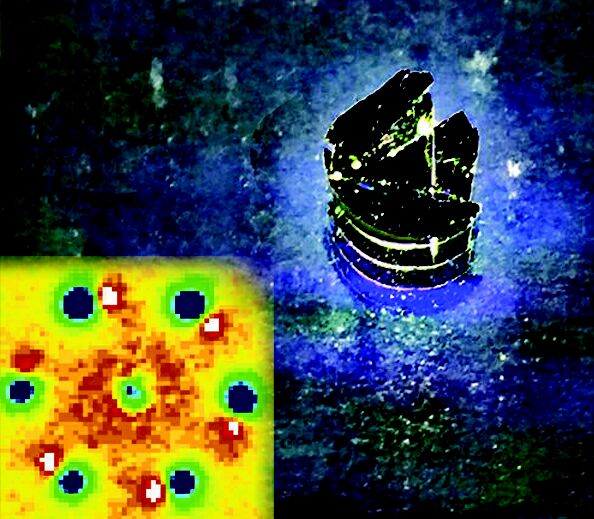 Characterizing and understanding the emergence of multiple macroscopically ordered
electronic phases through subtle tuning of temperature, pressure, and chemical doping
has been a long-standing central issue for complex materials research. In a recent
Science Advances article, we describe a high-fidelity approach that combines femtosecond
electron crystallography and controlled femtosecond photo-doping to reveal the ultrafast
structural dynamics of complex quantum phases in response to the photonic tuning of
interaction energy as an alternative route to chemical doping or applying pressure,
but without uncontrolled effects due to strain or disorder. We report a comprehensive
study of optical doping–induced emergence of stable phases and metastable hidden phases
in charge-density-wave tantalum disulfide materials. The electronic phase transitions
are triggered by mid-infrared pulses, and a temperature–optical density phase diagram
is constructed and substantiated with the dynamics of metastable states, highlighting
the cooperation and competition through which the macroscopic quantum orders emerge.
These results elucidate key pathways of femtosecond electronic switching phenomena
and provide an avenue to comprehensively investigate optical doping–induced transition
states. Furthermore, the speed and degree of photodoping substantially exceed that
achievable with conventional methods, creating opportunities to generate new phases.
The robust nonthermal switching at mesoscales and at ultrafast time scales may oneday
provide a platform for designing high-speed low-energy consumption nanophotonics and
electronics devices.
Characterizing and understanding the emergence of multiple macroscopically ordered
electronic phases through subtle tuning of temperature, pressure, and chemical doping
has been a long-standing central issue for complex materials research. In a recent
Science Advances article, we describe a high-fidelity approach that combines femtosecond
electron crystallography and controlled femtosecond photo-doping to reveal the ultrafast
structural dynamics of complex quantum phases in response to the photonic tuning of
interaction energy as an alternative route to chemical doping or applying pressure,
but without uncontrolled effects due to strain or disorder. We report a comprehensive
study of optical doping–induced emergence of stable phases and metastable hidden phases
in charge-density-wave tantalum disulfide materials. The electronic phase transitions
are triggered by mid-infrared pulses, and a temperature–optical density phase diagram
is constructed and substantiated with the dynamics of metastable states, highlighting
the cooperation and competition through which the macroscopic quantum orders emerge.
These results elucidate key pathways of femtosecond electronic switching phenomena
and provide an avenue to comprehensively investigate optical doping–induced transition
states. Furthermore, the speed and degree of photodoping substantially exceed that
achievable with conventional methods, creating opportunities to generate new phases.
The robust nonthermal switching at mesoscales and at ultrafast time scales may oneday
provide a platform for designing high-speed low-energy consumption nanophotonics and
electronics devices.
This work is a result of collaboration between Ruan, Duxbury, and Mahanti groups at MSU, and Kanatzidis group at Northwestern University.
(Science Advances 1, e1400173 (2015))
The resolution limit of ultrafast electron imaging and spectroscopy
The UEM collaboration (groups of Berz, Duxbury, and Ruan) zoomed in on the stochastic space-charge effects in the generation of high-brightness electron beams. Using a multilevel fast multipole method, coupled with the shadow imaging of femtosecond photoelectron pulses for validation, we quantitatively elucidate the photocathode, space charge and virtual cathode physics, which fundamentally limit the spatiotemporal and spectroscopic resolution and throughput of ultrafast electron microscope (UEM) systems[J. Appl. Phys. 111, 044316 (2012)]. A simple microscopic description to capture the nonlinear beam dynamics based on a two-fluid picture and elucidate an unexpected dominant role of image potential pinning in accelerating the emittance growth process. These calculations set theoretical limits on the performance of UEM systems and provide useful guides for photocathode design for high-brightness electron beam systems. electron imaging and spectroscopy [Appl. Phys. Lett. 103, 253115 (2013)]. Further improvement in time resolution may come through improving the source brightness, through for example; laser pulse shaping or tuning of the driving photons to threshold energy from a high-efficiency cathode; and may make ps macromolecular imaging feasible without the need to outrun the radiation damage effects, as required in the case of imaging using X-rays. Further quantitative details addresses the source-limited performance of ultrafast electron imaging and spectroscopy systems under various acceleration fields, and photo-electron pulse aspect ratios, namely the so-called pancake and cigar scenarios. The simulation results point to the interesting finding that a ps cigar beam indeed excels in coherence length ( up to 20 nm with 10^4 electrons and ~1nm with 10^8 electrons, however, the high acceleration field also increases its energy spread, whereas the energy spread of cigar-shaped beams is quite unaffected[J. Appl. Phys. 116, 174302 (2014)].Overall, the fs pancake beam has significantly smaller longitudinal emittance up to the virtual cathode limit, and is more suited for high combined temporal-spectral resolution UEDs, whereas the cigar beam may be suited for ps imaging, close to the single-shot limit. These projections show promising parameter space for conducting ultrafast electron microdiffraction at close to the single-shot level, which is supported by the latest experimental characterization of such a system [Proc. of SPIE, vol. 9198 (2014)].
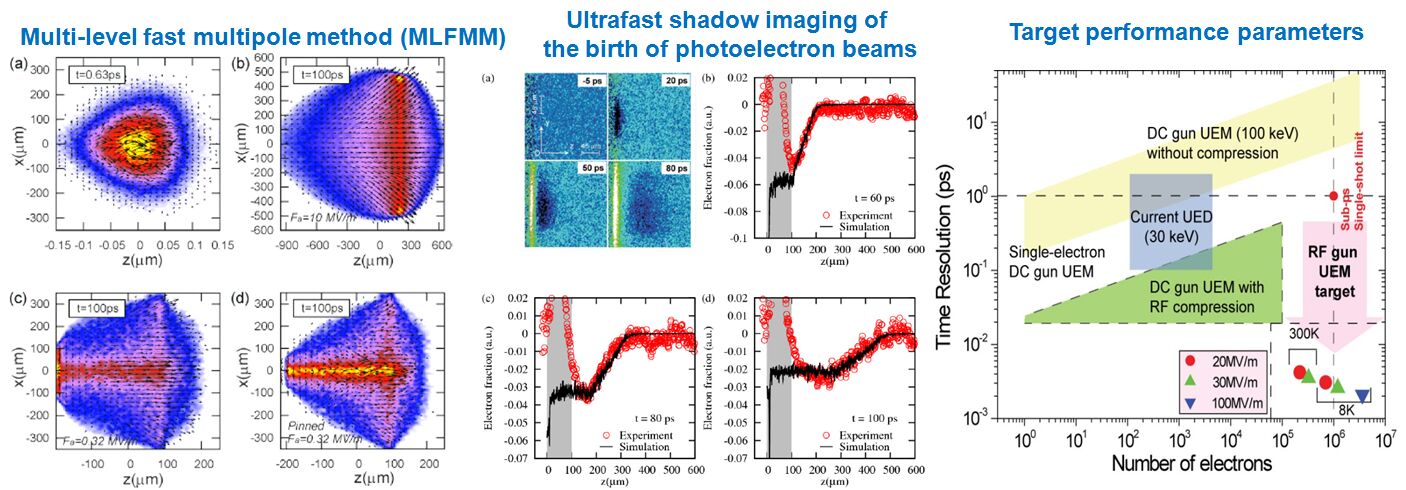
Decoupling of the electronic and structural phase transitions in VO2
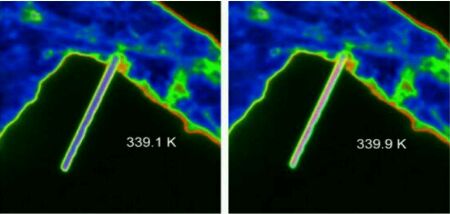 Using optical, TEM and ultrafast electron diffraction experiments we find that single-crystal
VO2 microbeams gently placed on insulating substrates or metal grids exhibit different
behaviors, with structural and metal-insulator transitions occurring at the same temperature
for insulating substrates, while for metal substrates a new monoclinic metal phase
lies between the insulating monoclinic phase and the metallic rutile phase, which
we show may be stabilized by charge doping. Informed by our ultrafast single-beam
measurements, the metal-insulator transition in the undoped case can be classified
as Mott-driven, Peierls-limited, where the imposed cooperativity is mainly governed
by the large spectral weight and the high energy scale inherent to the Peierls transition
and that such stabilizing features are subjective to the strong Coulomb interaction
predominant only in the insulating state without doping. We also uncover the unique
delocalized nature of the interface-mediated charge doping effect that can be rationalized
with an active spectral weight transfer from the unfilled band to the Peierls band
in the monoclinic structure, which enhances the Peierls interaction supported by its
selective effect on the structural phase transition temperature. While the results
presented here are very specific, they are generally compatible with the Peierls-Mott
scenario proposed by most recent theories, and amazingly reconcilable with an array
of different experiments supportive of either Peierls or Mott scenarios.
Using optical, TEM and ultrafast electron diffraction experiments we find that single-crystal
VO2 microbeams gently placed on insulating substrates or metal grids exhibit different
behaviors, with structural and metal-insulator transitions occurring at the same temperature
for insulating substrates, while for metal substrates a new monoclinic metal phase
lies between the insulating monoclinic phase and the metallic rutile phase, which
we show may be stabilized by charge doping. Informed by our ultrafast single-beam
measurements, the metal-insulator transition in the undoped case can be classified
as Mott-driven, Peierls-limited, where the imposed cooperativity is mainly governed
by the large spectral weight and the high energy scale inherent to the Peierls transition
and that such stabilizing features are subjective to the strong Coulomb interaction
predominant only in the insulating state without doping. We also uncover the unique
delocalized nature of the interface-mediated charge doping effect that can be rationalized
with an active spectral weight transfer from the unfilled band to the Peierls band
in the monoclinic structure, which enhances the Peierls interaction supported by its
selective effect on the structural phase transition temperature. While the results
presented here are very specific, they are generally compatible with the Peierls-Mott
scenario proposed by most recent theories, and amazingly reconcilable with an array
of different experiments supportive of either Peierls or Mott scenarios.
(Physical Review Letter 109, 166406 (2012) ; Physical Review B 87, 235124 (2013))
Tango dance of electrons and ions in the phase transition of two-dimensional charge-density waves
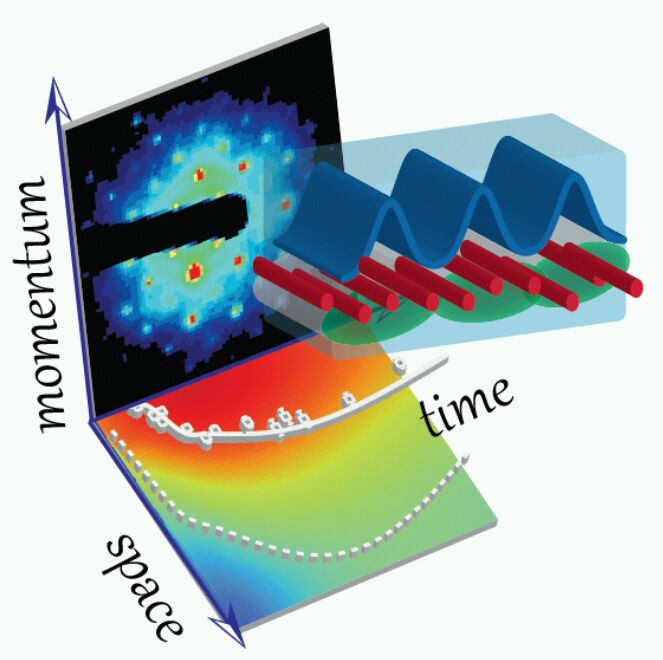 The coexistence of phases through complex couplings between different degrees of freedom
(spin, charge, lattice, orbital) is a hallmark of complex materials with emerging
properties such as charge density wave (CDW), superconductivity, and colossal magnetoresistivity.
In particular, CDW is predicted to form in highly anisotropic systems where long-range
charge ordering (CO) and periodic lattice distortion (PLD) are strongly coupled, driven
by instabilities originated in either the electronic (Mott) or phononic (Peierls)
subsystems. Recent femtosecond spectroscopy-based pump-probe techniques offered
real-time characterizations of nonequilibrium dynamics in the different regimes of
electron-phonon coupling, but their properties are elucidated in the temporal responses
representative of mostly the evolution of CO state. Using ultrafast electron crystallography,
we provided a complementary view from ultrafast electron crystallography investigation
of CeTe3, exploiting its elegant 2D weakly correlated feature, serving as an ideal system
to understand the symmetry breaking phase transition in a strongly coupled electron-phonon
system. We specifically examined the fluctuational dynamics using the momentum-dependent
dynamical diffraction features to address the open questions. Following a strong
perturbation of electron density, we observed clear evidence of nonconcerted suppressions
of CDW, expressed in the ionic frame as an unexpected 2D lattice hardening and a short-lived
topologically fragmented state in the long-range PLD network resulted from CO suppression,
and highly nonuniform fluctuational amplitudes that are signatures of strong anisotropic
electron-phonon coupling driving PLD, respectively. The nature of the transition was
explained using a three-temperature model, in which the first part of the dynamics
can be reconciled with the optical observations of electronic suppression; while the
second part manifested in the nonadiabatic ionic responses is highly system-dependent,
and informative of the electron-phonon mechanism for CDW formation.
The coexistence of phases through complex couplings between different degrees of freedom
(spin, charge, lattice, orbital) is a hallmark of complex materials with emerging
properties such as charge density wave (CDW), superconductivity, and colossal magnetoresistivity.
In particular, CDW is predicted to form in highly anisotropic systems where long-range
charge ordering (CO) and periodic lattice distortion (PLD) are strongly coupled, driven
by instabilities originated in either the electronic (Mott) or phononic (Peierls)
subsystems. Recent femtosecond spectroscopy-based pump-probe techniques offered
real-time characterizations of nonequilibrium dynamics in the different regimes of
electron-phonon coupling, but their properties are elucidated in the temporal responses
representative of mostly the evolution of CO state. Using ultrafast electron crystallography,
we provided a complementary view from ultrafast electron crystallography investigation
of CeTe3, exploiting its elegant 2D weakly correlated feature, serving as an ideal system
to understand the symmetry breaking phase transition in a strongly coupled electron-phonon
system. We specifically examined the fluctuational dynamics using the momentum-dependent
dynamical diffraction features to address the open questions. Following a strong
perturbation of electron density, we observed clear evidence of nonconcerted suppressions
of CDW, expressed in the ionic frame as an unexpected 2D lattice hardening and a short-lived
topologically fragmented state in the long-range PLD network resulted from CO suppression,
and highly nonuniform fluctuational amplitudes that are signatures of strong anisotropic
electron-phonon coupling driving PLD, respectively. The nature of the transition was
explained using a three-temperature model, in which the first part of the dynamics
can be reconciled with the optical observations of electronic suppression; while the
second part manifested in the nonadiabatic ionic responses is highly system-dependent,
and informative of the electron-phonon mechanism for CDW formation.
(Physical Review B 86, 075145 (2012); 87, 235124 (2013))
Imaging defects growth in silver nanoparticles excited through surface plasmons
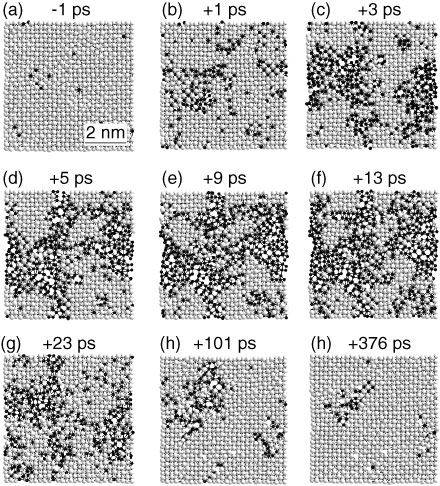 The ability to image defect growth processes is central to the understanding of the
electronically induced structural phase transitions in solids. The recent emergence
of using the transient optical doping method to actuate atomic motions by modifying
electronic structures of materials has opened up new vistas for exploring novel phases
of materials. Whereas optical and photoemission studies have provided significant
insights into the initial electronic processes that are strongly coupled to lattice
degrees of freedom, the mechanism bridging the femtosecond (fs) optical seeding to
the ps-to-ns macroscopic structural changes remains a central topic to be elucidated.
Recent developments in ultrafast diffraction techniques have enabled direct probing
of atomic dynamics and helped accentuate the important role of electronic excitation
in initiating the coherent motions, bond softening and structural transformations.
By employing ultrafast electron nanoscale crystallography , we demonstrate a direct
structural study of spatially inhomogeneous processes in Ag nanocrystals (NCs) induced
via surface plasmon resonance (SPR) excitation. Contrary to an impulsive process leading
to fragmentation, we find that the dominant dynamical feature in the prefragmentation
stage is a defect-mediated instability growth, creating sub-nanocrystalline domains
with hot surface and relatively cold core. Electronic effects are proposed to account
for the incipient creation and subsequent growth of lattice inhomogeneities directly
responsible for fragmentation, which are corroborated by the evidences of correlated
charge localization and defect percolation on the picosecond timescale following photoexcitation.
The ability to image defect growth processes is central to the understanding of the
electronically induced structural phase transitions in solids. The recent emergence
of using the transient optical doping method to actuate atomic motions by modifying
electronic structures of materials has opened up new vistas for exploring novel phases
of materials. Whereas optical and photoemission studies have provided significant
insights into the initial electronic processes that are strongly coupled to lattice
degrees of freedom, the mechanism bridging the femtosecond (fs) optical seeding to
the ps-to-ns macroscopic structural changes remains a central topic to be elucidated.
Recent developments in ultrafast diffraction techniques have enabled direct probing
of atomic dynamics and helped accentuate the important role of electronic excitation
in initiating the coherent motions, bond softening and structural transformations.
By employing ultrafast electron nanoscale crystallography , we demonstrate a direct
structural study of spatially inhomogeneous processes in Ag nanocrystals (NCs) induced
via surface plasmon resonance (SPR) excitation. Contrary to an impulsive process leading
to fragmentation, we find that the dominant dynamical feature in the prefragmentation
stage is a defect-mediated instability growth, creating sub-nanocrystalline domains
with hot surface and relatively cold core. Electronic effects are proposed to account
for the incipient creation and subsequent growth of lattice inhomogeneities directly
responsible for fragmentation, which are corroborated by the evidences of correlated
charge localization and defect percolation on the picosecond timescale following photoexcitation.
(Physical Review Letter 104, 123401 (2010) )
Imaging ultrafast photoelectron dynamics
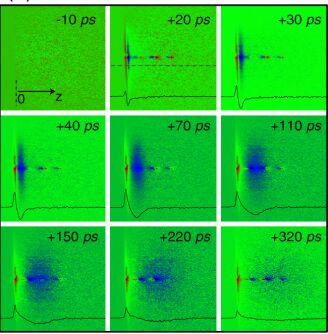 Understanding the mechanism of vacuum space charge emission and surface charge accumulation
is crucial to the development of pulsed laser driven electron technologies, such as
time-resolved photoemission, ultrafast electron diffraction and microscopy. Recently,
a novel method to directly image the spatiotemporal evolution of the photoemitted
electron packet generated over a femtosecond laser excited surface has been developed
in UEC group . This method possesses sufficient sensitivity to image electron density
as small as 10^10 e/cm^3 and permits quantitative measurement of the instantaneous
electron density distribution and its collected translational and expansion speed
near the surface. These initial kinetic energy distributions are representative of
the hot electron profile within the materials responsible for the photoemission. This
technique thus can provide information equivalent to those obtained from time-resolved
photoemission spectroscopy, but can be operated at a strongly driven condition with
a direct resolution to distinguish the presence of space charge effects. In the study
of photoemission from a graphite surface, we found that the dynamical profile of photoelectrons
reveals an origin of a thermionic emission, followed by an adiabatic process leading
to electron acceleration and reduction of electron expansion (cooling). The hot electron
emission is found to couple with a surface charge dipole layer formation, with a sheet
density several orders of magnitude higher than that of the vacuum emitted cloud.
Understanding the mechanism of vacuum space charge emission and surface charge accumulation
is crucial to the development of pulsed laser driven electron technologies, such as
time-resolved photoemission, ultrafast electron diffraction and microscopy. Recently,
a novel method to directly image the spatiotemporal evolution of the photoemitted
electron packet generated over a femtosecond laser excited surface has been developed
in UEC group . This method possesses sufficient sensitivity to image electron density
as small as 10^10 e/cm^3 and permits quantitative measurement of the instantaneous
electron density distribution and its collected translational and expansion speed
near the surface. These initial kinetic energy distributions are representative of
the hot electron profile within the materials responsible for the photoemission. This
technique thus can provide information equivalent to those obtained from time-resolved
photoemission spectroscopy, but can be operated at a strongly driven condition with
a direct resolution to distinguish the presence of space charge effects. In the study
of photoemission from a graphite surface, we found that the dynamical profile of photoelectrons
reveals an origin of a thermionic emission, followed by an adiabatic process leading
to electron acceleration and reduction of electron expansion (cooling). The hot electron
emission is found to couple with a surface charge dipole layer formation, with a sheet
density several orders of magnitude higher than that of the vacuum emitted cloud.
(Applied Physics Letter 95, 181108(2009))
August 2009: MSU Strategic Partner Group formed to develop high-brightness femtosecond electron microscope
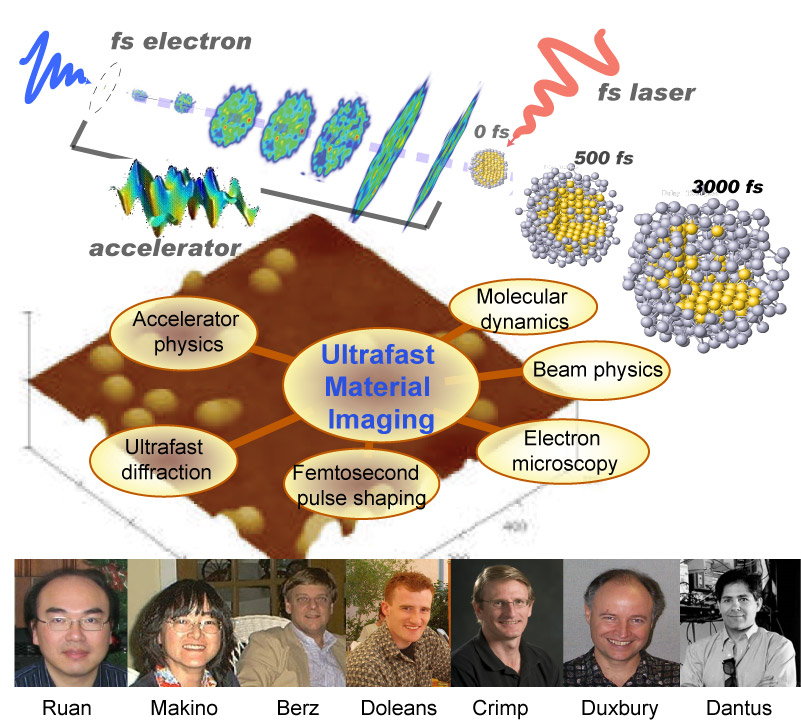
Quantitative modeling of excited state structural dynamics to visualize surface melting of Au nanoparticles
Our group developed a progressive refinement method to treat excited state ultrafast diffraction patterns by adopting a reverse Monte Carlo approach to refine the excited state structures . The tracking of particle dynamics is constrained by using the inherent dynamical correlations between structural functions obtained from two neighboring time frames. The ability of 'making molecular movies' is tantalizingly close from analyzing the photoinduced structural dynamics for the strong scattering Au and Ag nanoparticles, based on this method.
(Microscopy and Microanalysis Vol. 15, 323-337; Special issue on ultrafast electron microscopy and ultrafast sciences)
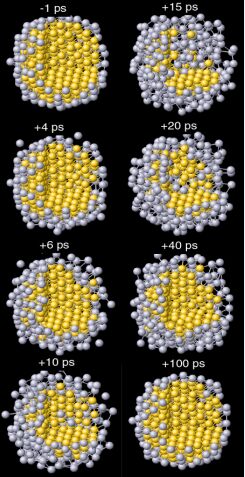
Shaping up graphite with light
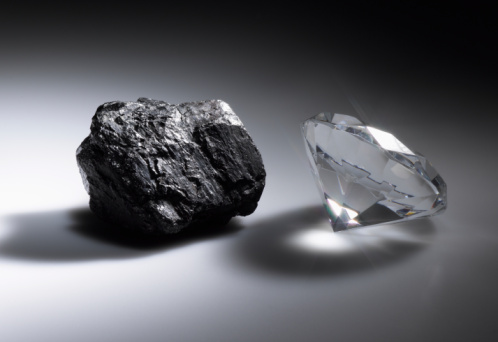 Can we make diamond from graphite without resorting to extreme heat and pressure as
diamond was made in the Earth in geological time? The UEC team raise such a possibility
by shining a short burst of intense femtosecond laser pulse on graphite and watching
using ultrafast diffraction the movements of some loosely separated carbon atoms in
graphene layers undergoing rehybridization, forming more tightly bound diamond-like
bonds. Whereas this intriguing intermediate structure is short-lived, approximately
for 30 picoseconds, this experiment shows the possibility of a structural transformation
purely induced by light in this very versatile class of material. Assisted by density
functional theory calculation performed by Tomanek's group at MSU, the cause for such
a transformation is attributed to the electronic structure changes and the Coulomb
field buildup following the photoexcitation. We are currently exploring different
strategies in optically converting graphite into more permanent form of diamonds on
graphite surface and ultrathin slab.
Can we make diamond from graphite without resorting to extreme heat and pressure as
diamond was made in the Earth in geological time? The UEC team raise such a possibility
by shining a short burst of intense femtosecond laser pulse on graphite and watching
using ultrafast diffraction the movements of some loosely separated carbon atoms in
graphene layers undergoing rehybridization, forming more tightly bound diamond-like
bonds. Whereas this intriguing intermediate structure is short-lived, approximately
for 30 picoseconds, this experiment shows the possibility of a structural transformation
purely induced by light in this very versatile class of material. Assisted by density
functional theory calculation performed by Tomanek's group at MSU, the cause for such
a transformation is attributed to the electronic structure changes and the Coulomb
field buildup following the photoexcitation. We are currently exploring different
strategies in optically converting graphite into more permanent form of diamonds on
graphite surface and ultrathin slab.
(Broken Link)(PR focus article)
( (Broken Link)Phys. Rev. Lett. 101, 077401 (2008))
Measuring photovoltage at ultrafast speed
We detailed a method to directly measure the photovoltage at nanointerfaces using femtosecond electron pulses. The transient surface voltage is determined by observing Coulomb refraction changes induced by interfacial charging. Using coherent diffraction signal, we can trace the origin of the refractive beam trajectory in material, thus obtain the nanoscale scale sensitivity of the charge transfer process. We are currently extending this approach to investigate molecular electronic processes.
(Phys. Rev. B 77, 245329 (2008)).
Ultrafast Meets Ultrasmall
Our first paper outlining ultrafast electron nanocrystallography and the studies of photomelting of size-selected Au nanoparticles is now published online (Nano Letters: Author ASAP). Download PDF: with subscription, without subscription.
We report in the Nano Letters the studies of ultrafast electron nanocrystallography on size-selected Au nanoparticles (2-20 nm) supported on a molecular interface. Reversible surface melting, melting, and recrystallization were investigated with full-profile atomic density maps determined with sub-picosecond and picometer accuracies. In the ultrasmall environment, the melting process induced by photons is ultrafast and far-from-equilibrium, transforming nanocrystals into shelled nanoliquids. The energy of the photons is transferred to the atoms within just a few picoseonds. However, it takes tens of picoseond for the atoms to be released from the crystalline motif into a liquid shelled structure. This dynamical transformation is strongly influenced by a coherent shearing motion within fcc structure that is determined as the pathway leading to the photomelting. The nanoliquids is more icosahedral-like, and it reverts to the fcc crystalline state in 100 ps. The structural excitation is displacive which results in a coherent transformation with crystal/liquid coexistence and that differs from the reciprocal behavior of recrystallization, where a hot lattice forms from liquid and then thermally contracts. The degree of structural change and the thermodynamics of melting are found to depend on the size of nanoparticle. The reversible and coherent transformation on the ultrafast time scale demonstrates the directed dynamics on the energy landscape of finite systems. This methodology is general and could be implemented to study a wide class of phenomena pertaining to nanoscaled materials.
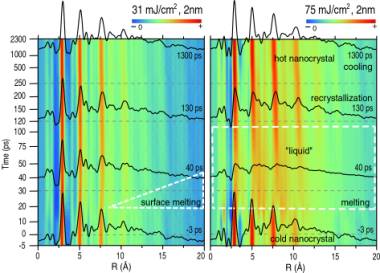
Time-resolved melting dynamics of 2nm Au nanoparticles. (Left) Radial distribution function (RDF) map constructed by stacking RDF of UEC patterns at a sequence of delays between -5-2300 ps at irradiation fluence F=31 mJ/cm2. Surface melting (enclosed by the dashed white line) is visible. (Right) RDF map for F=75 mJ/cm2. Full scale melting is observed. The liquid state (enclosed by dashed white line) is characterized by the drop of 2nd nearest density (at ~ 5Å) to (1-1/e) of the static value (at negative time).